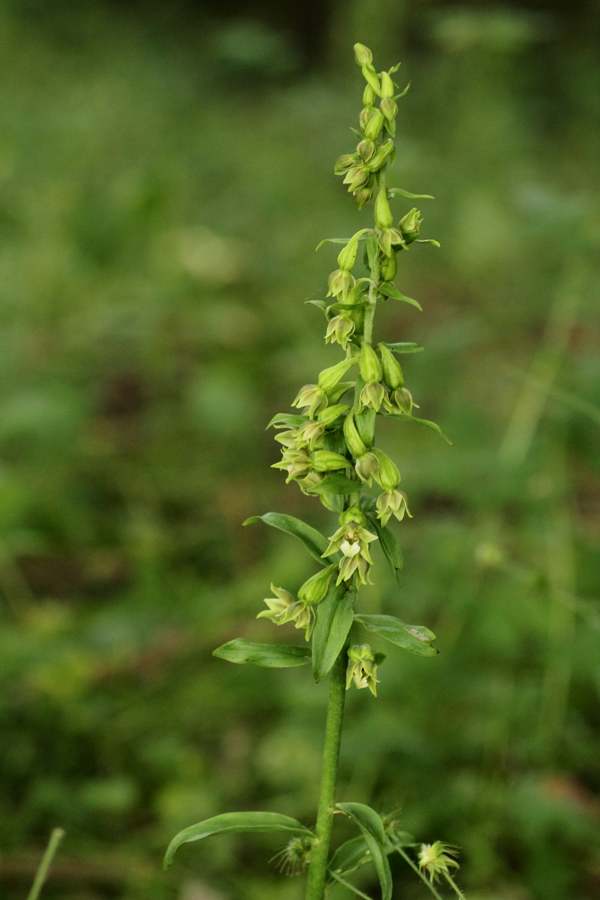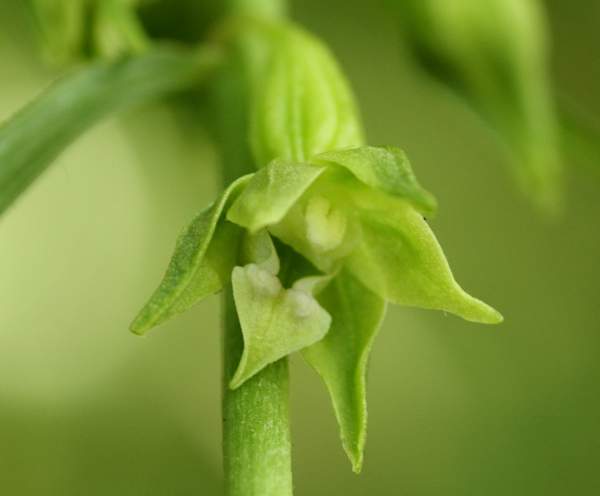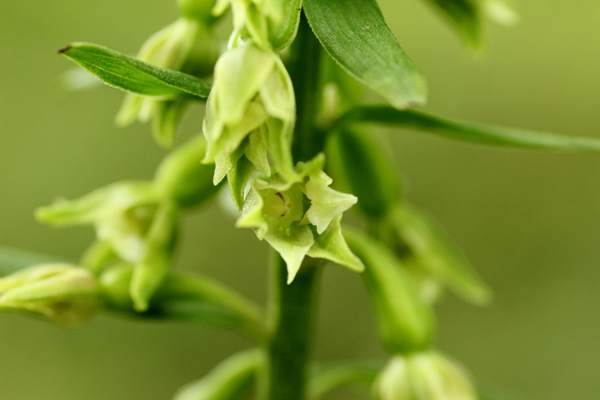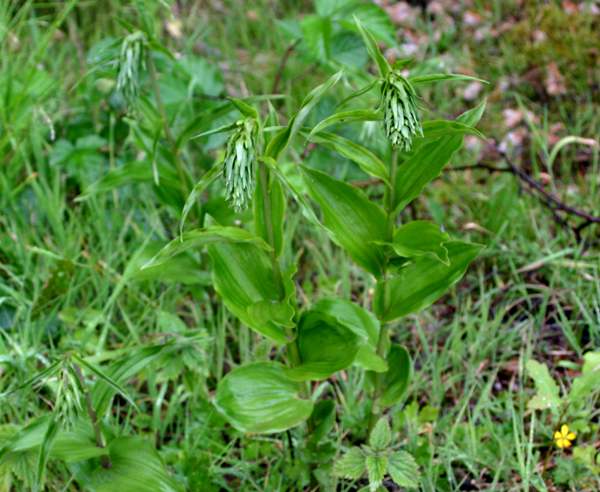Trees Birds Mammals Fish Amphibians Reptiles
Wild Algarve
Bookshop
Epipactis phyllanthes - Green-flowered Helleborine
Phylum: Magnoliophyta - Class: Liliopsida - Order: Orchidales - Family: Orchidaceae

The flowering of Green-flowered Helleborine is sporadic and the fact that it blends in so well with its background makes it one the most difficult orchids to find. Its appearance is also variable making accurate identification very problematic.
Description
The plant grows up to about 40 cm in height with a series of well-spaced leaves in facing ranks on either side of the stem. The inflorescences have around 20 individual flowers which seem to be almost permanently in bud. When the flowers do open they only open partially revealing a paler green lip which may sometimes be flushed with pink.

The variability of this species has led to plants in some areas being described as varieties of Epipactis phyllanthes including Epipactis phyllanthes var. vectensis, Epipactis phyllanthes var. cambrensis and Epipactis phyllanthes var. pendula
Distribution
The range of this plant is rather difficult to determine with any degree of accuracy because it is frequently confused with other Epipactis species.

Green-flowered Helleborine in wooodland in Wales. Pictures: Elaine Hagget...
Epipactis phyllanthes occurs in scattered colonies throughout England in Dorset, Kent, Norfolk and Cumbria. In Wales it occurs in some coastal dune systems, particularly at Kenfig National Nature Reserve, Whitford Burrows and Morfa Dyffryn. In Flintshire it occurs in woodland. In Ireland there are sites in Co. Dublin, Leitrim and Fermanagh.
Epipactis phyllanthes is also recorded in parts of western Europe from Denmark south to Belgium, France and northern Spain.
Habitat
Green-flowered Helleborine grows in coastal dunes and woodlands. In deepwoodland the plants are sometimes shorter and have fewer flowers.

Epipactis phyllanthes in Hampshire in June
Flowering times
Green-flowered Helleborine flowers from July to September.
Varieties and Hybrids
Varieties:
Epipactis phyllanthes var. phyllanthes has a lip which is not divided and looks more like a petal.
Epipactis phyllanthes var. pendula has a large and more typical lip which is divided into two; its flowers open fully.
Epipactis phyllanthes var. vectensis is similar to Epipactis var. pendula but the hypochile is smaller and the epichile is distinctly longer than the
hypochile.
Epipactis phyllanthes var. degenera is an intermediate between Epipactis var. vectensis and Epipactis var. phyllanthes with a small depression in place of a full hypochile and a flattened epichile which may only have very small bosses; its lip is 'waisted' rather than distinctly divided.
Etymology
The genus name Epipactis is an ancient Greek name of a plant said to be capable of curdling milk (perhaps a Hellebore). The type species of this genus is Epipactis helleborine, the species name of which means 'like a hellebore' - a reference to a physical resemblance in this instance. The specific epithet phyllanthes means 'leaf-flowers' and may refer to the fact that the leaves and flowers are the same colour.
Reference sources
The Plant List
Sue Parker (2023) Wild Orchids of Wales - how, when and where to find them; First Nature e-book (Amazon Kindle format)
Anne and Simon Harrap (2005) Orchids of Britain and Ireland; A&C Black
Pierre Delforge (2005) Orchids of Europe, North Africa and the Middle East; A&C Black
Den Nordiska Floran (1992) Bo Mossberg, Stefan Ericsson and Lennart Stenberg; Wahlstrom & Widstrand
Sue Parker's latest ebook is a revised and enlarged edition of Wild Orchids in The Burren. Full details here...
Buy it for just £5.95 on Amazon...
Sue Parker's new ebook is a comprehensive and fully revised edition of her acclaimed field guide to the Wild Orchids of Wales. Full details here...
Buy it for just £5.95 on Amazon...
Sue Parker's 5-star acclaimed field guide to the Wild Orchids of the Algarve is now available as an ebook. Full details here...
Buy it for just £5.95 on Amazon...
Please Help Us: If you have found this information interesting and useful, please consider helping to keep First Nature online by making a small donation towards the web hosting and internet costs.
Any donations over and above the essential running costs will help support the conservation work of Plantlife, the Rivers Trust and charitable botanic gardens - as do author royalties and publisher proceeds from books by Pat and Sue.